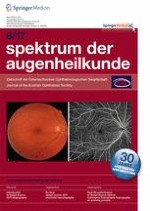21.07.2017 | Angio-OCT/Medical Retina
En face swept-source OCT choroidal vasculography (CVG)
Erschienen in: Spektrum der Augenheilkunde | Ausgabe 6/2017
Einloggen, um Zugang zu erhaltenSummary
Purpose
To describe a method for the visualization of choroidal vascular structures using swept-source optical coherence tomography (OCT)-A data sets.
Methods
Data sets of 9 mm × 9 mm with 512 × 512 A OCT-A scans were collected from patients with various diseases using a Topcon DRI OCT Triton® Swept Source OCT. The en face OCT data were inverted and 26 µm Bruch’s membrane fit slabs were created using Topcon IMAGEnet 6 1.21 viewer software. This slab was moved through the choroid at 2.6 µm intervals in order to create a fluid fly-through of the choroidal vasculature. The slab was moved to a depth of up to 450 µm beneath the Bruch’s membrane. Where available, the indocyanine green angiography (ICG) of the same patient was compared with the resulting visualization.
Results
A total of 20 data sets from 10 patients were collected for this initial evaluation. The pathologies included 5 central serous chorioretinopathy (CSCR) patients, 3 diabetic retinopathy (DRP) patients, one sub choroidal mass, and one normal patient. The inversion of the en face data made the vessels clearly visible in the visualization. The high density of the OCT-A scans made it possible to visualize even small vessels in Sattler’s and Haller’s layer. In the cases where a comparison with ICG was possible there was a high correlation between the imaging modalities. As with OCT-A, leakage was not visible.
Conclusions
This is an effective method of visualizing the choroidal vasculature. It is comparable to ICG in visualizing the choroidal vascular structure. It of course does not show leakage. As it does not show blood flow like OCT-A but shows vascular structures, we propose the term choroidal vasculography (CVG) to describe this method. The clinical relevance of this method needs to be studied further.
Anzeige
